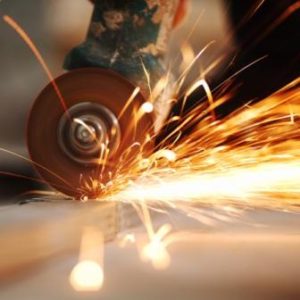Grinding Operation
Grinding Operation is generally called as fine machining or finishing operations of removing materials from surface usually 0.25-0.50 mm in most operations through the use of grinding wheel. Grinding wheel is highly useful in removing extra unwanted metal and sharpening cutting tools such as chisels, drill, taps, and other cutting tools. It may be used to finish almost all surface, which has been previously roughly shaped by some other processes or to remove the extra material which is too hard to be removed by other machining processes. The accuracy in fine grinding is in few microns or even less. In grinding, the work is held pressed against the high speed rotating grinding wheel and the metal gets reduced by abrasion. Grinding wheel is generally made from silicon carbide or aluminium oxide. It is generally made up of
particles of hard substance called the abrasive and is embedded in a matrix called the bond.
These abrasives form the cutting points in a wheel and are termed as grains. The abrasives are of generally two types namely natural and artificial. Emery and corundum are two natural abrasives, while carborundum and aloxite are artificial abrasives. The hardness or softness of the wheel is dependent on the amount and kind of the bonding material. Generally, hard wheels of aloxite are used for grinding soft materials and soft wheels of carborundum for grinding hard materials using various types of grinding machines known as grinders. In wet grinding, large amount of coolant over the work and on wheel face is provided. Coolant will remove heat generated during grinding and promotes long wheel life and produces very good surface finish. The cutting face of a grinding wheel should be kept in a true, clean and sharp conditioned shape for obtaining efficient cutting. Suitable dressers are also employed periodically for reconditioning and dressing of glazed or blunt wheels. Grinder may be various types such as cylindrical grinder, surface grinder, pedestal grinder, tool and cutter grinder, centre-less grinder, internal grinder and jig grinder and profile grinder. Fig. illustrates the surface grinding machine and principle of surface grinding. Fig. illustrates the principle of cylindrical grinding. Source A Textbook of Basic Manufacturing Processes and Workshop Technology by Rajender Singh.













Post Comment
You must be logged in to post a comment.